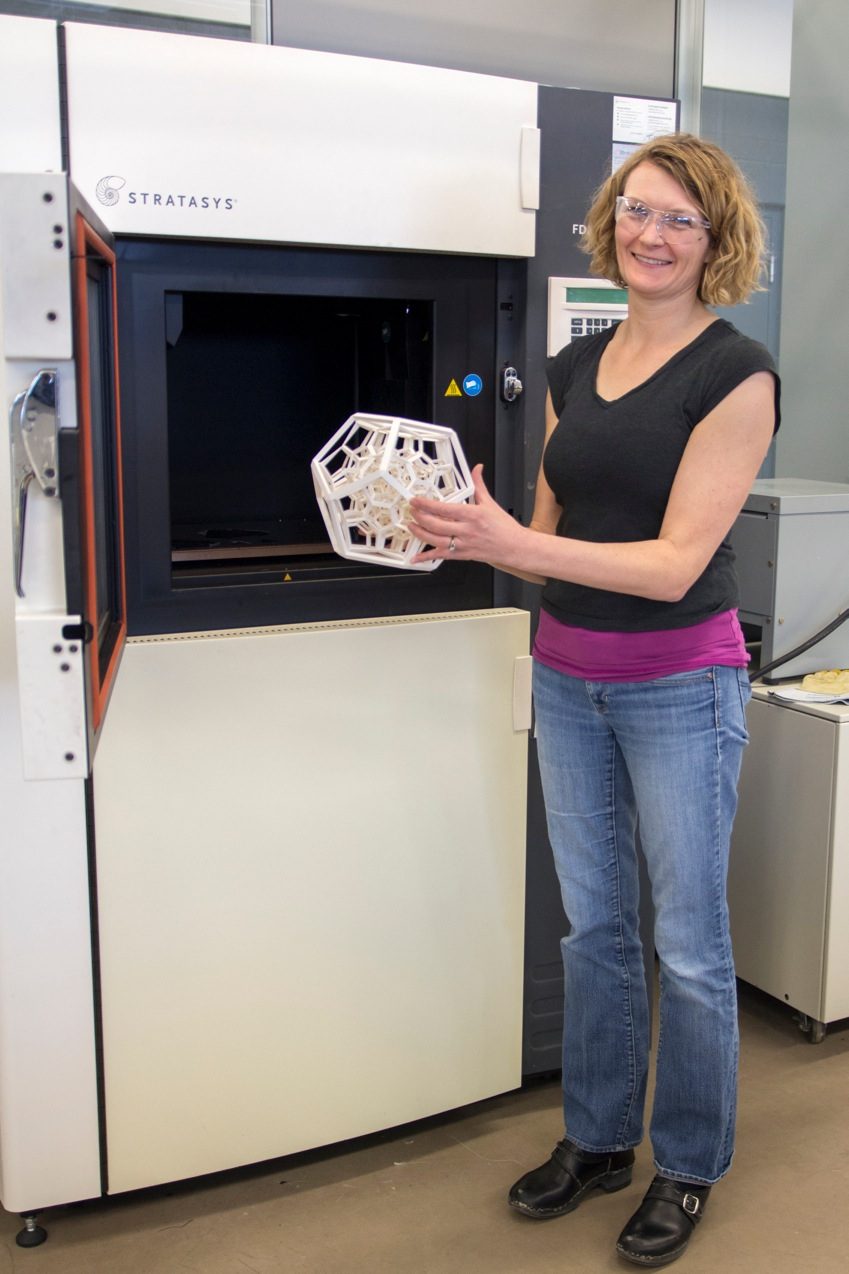The 3D printer at Red Deer College is a well-used machine that has been key in helping to develop prototypes for various industries, including medical trauma equipment and aviation.
There are two types of printers at the College. One is a manufacturing grade industry machine and the other a desktop version that is used primarily as a teaching tool.
Alicia Cafferata-Arnett is a project coordinator of Applied Research and Innovation at Red Deer College. She has been working with the printers for a number of years and has seen the ways they can be utilized in industry production.
“I guess a very basic definition is that you build up three dimensional objects with a substrate. That substrate can be plastic, cellular (stem cells), cement, paper or even chocolate. Essentially you build up a solid object. It’s the same as a printer in that there are x and y planes, but then it builds in the z direction,” she explained.
“The most common printer substrates are plastic, of which there are two main kinds. One is called a fluid deposition model and that drops tiny beads of plastic onto each other to build. The other kind uses a powder and is cured by a laser into shape.”
Most desktop 3D printers use the fluid deposition model.
The majority of the printing that Cafferata-Arnett works with is used to prototype objects for industry development. She said the niche of 3D printing in the manufacturing world is with objects that are used for a short amount of time during a testing phase.
However, 3D printing technology is also able to produce usable, manufacturing grade objects on site in industries such as aviation, agriculture and the military.
“For example, the military used to have to order thousands of parts in order to get the five parts that they needed. Now, they can just 3D print them on site and use them.”
At RDC, the desktop printer is used to aid in things like science programs or for sculpting models within art studies. The students don’t use the manufacturing grade because there is a higher cost associated with the substrates, as well as more time consumed to produce a higher-quality product.
There are some key differences between the printers including a vast price difference, size and the materials that are used in each.
“Our manufacturing-grade machine is about $150,000 US. The desktop model in our lab is about $3,000. Some of the big differences are the material that goes with the manufacturing grade is highly controlled and is traceable. That’s really important especially if you’re putting parts in things like airplanes,” Cafferata-Arnett said.
“The other thing is that right now the manufacturing grade machine comes with a soluble support. What that means is that you can build really, really intricate parts in this machine. Once all the support material dissolves away, you actually have a functioning prototype. Everywhere there is a clearance required, the soluble support goes into that clearance and leaves the space.”
The desktop printer in the Innovation and Manufacturing Centre is open to air, unlike the manufacturing grade. This means the plastic models are cooling slightly between each layer, creating gaps and air bubbles that make the final product less sturdy.
“These envelopes (substrates) are heated to different temperatures depending on the plastic. That means that when you’re done the object, the layers compress together and become a bit stronger of an object. With the desktop model, it’s open to the air so as you’re laying the plastic down, it’s cooling. That leaves almost a fine fault line, making it less sturdy than a manufacturing grade object.”
One of the ways the manufacturing-grade printer at RDC was utilized involved the development of something called a trauma clamp.
“We were a tiny portion of this, but a critical portion in that we were able to go through about 40 replications of the design. We would print it out, the industry people would take it back, feel it, touch it, see what they did or didn’t like about it, make their design changes and then come back to us and the cycle would continue,” said Cafferata-Arnett.
“What they ended up with is a clamp that has small spikes that is used to close bullet holes, stab wounds, etc. You clamp in the piece and it stops people from bleeding out.”
To access the machines, entrepreneurs or company representatives approach RDC with an idea. People can contact Cafferata-Arnett directly at Alicia.cafferata@rdc.ab.ca or simply call the College and ask to be put through to the Centre of Innovation and Manufacturing.
Once people call, they will be connected to a design engineer to come up with a 3D model file. If they already have this, this file can be emailed to the College for a quote. That file gets entered into a program and a tool path for the 3D printer to develop the substrate.
RDC works on a fee-for-service model, with a base price and then a price per hour based on the substrate. The most commonly used substrate is ABS plastic. The strongest type of material available at RDC is ultem.
Cafferata-Arnett mentioned that RDC does not seek intellectual property or loyalties for any services provided. She said the contracts and agreements are all confidential to ensure industry security.
kmendonsa@reddeerexpress.com



